Crammed with amazing architecture, a colorful history and some great local eateries, Lalitpur is full of surprises.
King Sri Bir Deva while sitting at the window of his palace used to see a grass cutter suffering from leprosy going to cut grass regularly. One day, to his astonishment, he saw the grass cutter cured of his leprosy and looking very handsome. Upon questioning, the grass cutter stated that he had gone to the southern shore of the Bagmati River into the Lalita woods to cut grass. Feeling hot he had stuck his carrying pole into the ground and taken a bath. On finishing, he noted that he had been cured of his leprosy and his pole was firmly stuck to the ground.
build a magnificent capital city for some time. The great god Shiva appeared to him in a dream and told him to cut down the Lalita wood, design it in accordance with the 24 elements in the shape of a mandala and make his minister, the grass cutter the architect. In the bright half of the month of Falgun, the minister inaugurated the building of the new city. The king created 24 toles (localities, pronounces similar to poles) representing the elements and an extremely beautiful city called Lalitapattana was born. Thus reads one of the main founding myths of the city of Lalitpur.
 City with many names
City with many names
The city of Lalitpur, to the South of the Bagmati River has three names – Patan, Lalitpur and Yala. Patan is the most commonly used name but the formal name of the city and the district is Lalitpur, which means beautiful city. Patan may be an abbreviation of the ancient name of the city Lalitapattana while Yala is the Newari name for the city.
According to David Gellner in his article on the history of Lalitpur, the name ‘Yala’ could be a derivation of Yupagrama, which means ‘village of the sacred pillar.’ Yala was the largest of the villages combined to form the city of Lalitpur.
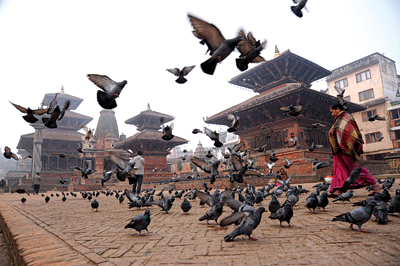 All at Sea
All at Sea
My first visit to the city of Lalitpur was in 2001 when I attended a workshop at Hotel Himalaya in Kupondole. Prof. Hemang Dixit, the noted medical educator and Dervla Murphy, an Irishwoman, have shown us glimpses of Lalitpur from the 1950s and 1960s in their books titled ‘My 2 innings’ and ‘The waiting land’. The city was much less crowded then, with the city seeing an exponential rise in population in the last decade. On shifting to the crowded chaos of Lalitpur after the peace and calm of Pokhara, I initially found living there very difficult.
Gwarko Chowk of Ring Road must be one of the most challenging road junctions in Kathmandu. Traffic comes from all direction (not just the four cardinal ones) and walking along the narrow road leading from Gwarko to Mangal Bazaar and beyond is an art. I always wonder how pedestrians and vehicles manage to occupy the same space without a fatal collision. In my initial days, this was my route to Mangal Bazaar until I discovered a quieter and more peaceful one through the by lanes.
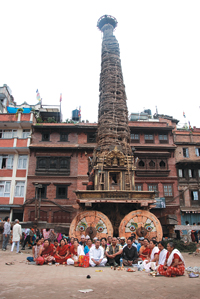 Lalitpur is regarded amongst the oldest settlements in Nepal and has more association with the pre-Licchavi and Kirati period than other cities of the valley. The Licchavis and Kirats were two dynasties who ruled the Kathmandu valley in ancient times. The town is said to have been founded by the Kiratis in the 3rd century BC and was expanded later by the Licchavis. There is a legend about three people from the Kathmandu valley bringing the Rato Matsyendranath deity all the way from Assam, India. A person called Lalit played an important role in settling the God in Lalitpur. Matsyendranath is the god of rain and an annual chariot festival is held in his honor. The deity spends six months of the year in the village of Bungamati and is carried in a procession to Lalitpur. The chariot is a spectacular affair with the wood and jute spire rising over sixty feet from the ground. The chariot is pulled by local devotees in a merry procession through different parts of the city spending time in each locality.
Lalitpur is regarded amongst the oldest settlements in Nepal and has more association with the pre-Licchavi and Kirati period than other cities of the valley. The Licchavis and Kirats were two dynasties who ruled the Kathmandu valley in ancient times. The town is said to have been founded by the Kiratis in the 3rd century BC and was expanded later by the Licchavis. There is a legend about three people from the Kathmandu valley bringing the Rato Matsyendranath deity all the way from Assam, India. A person called Lalit played an important role in settling the God in Lalitpur. Matsyendranath is the god of rain and an annual chariot festival is held in his honor. The deity spends six months of the year in the village of Bungamati and is carried in a procession to Lalitpur. The chariot is a spectacular affair with the wood and jute spire rising over sixty feet from the ground. The chariot is pulled by local devotees in a merry procession through different parts of the city spending time in each locality.
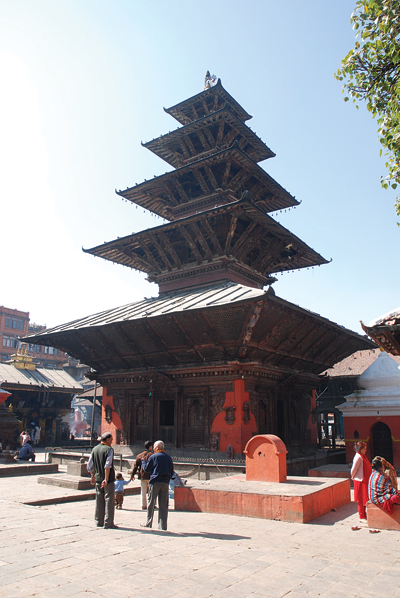 Ancient traditions of Lalitpur
Ancient traditions of Lalitpur
One of my favorite walks in Lalitpur is to turn to the right from the main road to Mangal Bazaar from Gwarko and then walk through narrow brick paved streets with tall houses on either side. There are ancient temples at major junctions, which are well maintained and play an important part in local cultural traditions even today. Guthis, a communal body of the Newars with many important functions like worship, cultural processions, funeral rites and upkeep of temples are common in the valley and wherever Newars have settled in Nepal. There are two big guthi buildings near Gwarko which are often used for communal feasts and celebrations. The houses are a mix of the traditional and the modern. There are also modern houses built in the traditional style with red bricks, brick carvings and traditionally carved windows. Buddhism was and is an important religion in the city and many shrines show both Buddhist and Hindu influences. In Nepal, many traditionally Hindu deities have been adopted by other religions also with different names. Traditional Buddhist deities are also worshipped by Hindus. Many deities have feminine manifestations which are worshipped as goddesses adding to the complexity. Resting places and small squares lend a homely atmosphere.
It is a matter of pride that ancient traditions and methods are still alive and thriving in Lalitpur. In many parts of the civilized world, the skill of working with the hand has vanished or is in decline. Lalitpur and other parts of the valley still maintain rich handicraft traditions. Stone carving, wood carving, metal works are all still carried out. Lalitpur is famous in Nepal as the city of artists and artisans. I always wonder at the ‘magic’ which these skilled craftsmen achieve using the simplest of tools. The skills and the materials to construct ancient temples and palaces still exist in the city.
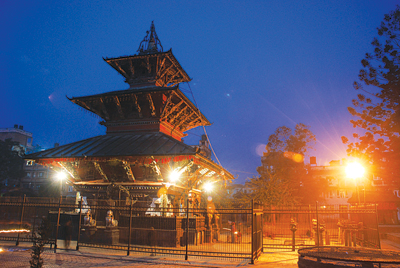 Patan Durbar Square
Patan Durbar Square
Kathmandu valley with a rich tradition of art, culture and architecture has seven World Heritage Sites. One of them is the Patan Durbar square. The square is the center of all heritage and other activities in the city. According to the website of the Lalitpur sub-metropolitan city, (www.lalitpur.org.np) there are 19 monuments in and around the square. In Nepal, religion is an integral part of life, and temples, houses and palaces are found in close proximity. The durbar square has been described in detail in many articles. The majority of temples in the square are in the traditional pagoda style of architecture supposed to have originated in Nepal and taken by the great architect, Arniko to Tibet from where it spread to China and the orient.
The Patan Museum is the converted residence of the old Malla Kings of Patan. It once served as the palace of the noted king Yoganarendra Malla. The museum’s exhibits cover a long period of Nepal’s cultural history and some rare objects are among its treasures. Their meanings and contexts within the living traditions of Hinduism and Buddhism are explained. Most are cast bronzes and gilt copper repousse work and traditional crafts for which Patan is famous. There are sculptures of Hindu and Buddhist deities created in the Kathmandu Valley, many in the nearby workshops of Patan itself. Others originated in India, Tibet and the western Himalayas. They are accompanied by written commentaries that attempts to explain their spiritual and art historical significance as part of the cultural heritage of Nepal.
Patan’s Durbar Square can be regarded as being integrated into the lives of the locals. There are throngs of people at all hours of the day and night. There are many restaurants here from which to enjoy a beautiful view of the square, or you can sit on the steps of the many monuments around and watch the unceasing human drama. I was particularly lucky to have seen a Newari Buddhist procession winding its colorful way through the square. The square has three courtyards: the Keshab Narayan Chowk, Mul Chowk and Sundari Chowk (chowk meaning courtyard). The Krishna Mandir dedicated to the Hindu deity Krishna, one of the incarnations of Vishnu was built by King Siddhi Narsingh Malla. This is one of the square’s most distinctive architectural treasures. Sundari Chowk has one of the grandest baths in the world, Tusha Hiti and one of the Malla kings was said to have slept here on cold nights and sit during monsoon rains with the objective of attaining eternal bliss. The director Bernardo Bertolucci used it as Prince Siddhartha’s bath in the 1994 film ‘Little Buddha’. Mulchowk served as the actual residence of the royal family. The golden temple, the Bhimsen temple, Degu Taleju and Taleju Bhawani temple are among the many attractions.
Temples and stupas
The Kumbeshwor Mahadev temple is one of the oldest temples in Patan believed to have been constructed in 1392 as a two-story shrine. In the 17th Century, the King Srinasava Malla added the upper three stories. Along with the Nyatpola in Bhaktapur, it is one of the two five-storied temples in the valley. Of special interest to me is the supposed underground connection of the ponds here with the Gosainkund Lake high in the Helambu region. The sacred waters of Gosainkund may thus be accessible in Patan. A pilgrim at Gosainkund is said to have dropped his pot (kumbha) into the lake. The pot appeared much later at the water tank of the temple giving rise to the belief in an underground channel and giving Lord Shiva yet another name of Kumbeshwor (Lord of the pots).
Matsyendranath Mandir (temple) is dedicated to the Rato Matsyendranath who has been described as the god of many guises. To the Newars, he is known as Bunga Dya, a manifestation of Karunamaya. He is Avalokiteshwara, the god of compassion to traditional Buddhists. There is an interesting legend about this deity. Gorakhnath once visited the valley and was offended that he was not accorded a proper reception. He caused a drought in the valley by rounding up all the snakes that bring rain and sitting on them, allowing none to escape. Matsyendranath was brought from Assam and Gorakhnanth had to get up to pay homage to his guru. The snakes escaped, bringing life giving rain to the valley.
Both the Buddha and the emperor Ashoka are supposed to have visited the valley. However, many historians doubt this. Ashoka is said to have built four Ashoka stupas. These are at Imadol in the East, Ibahi in the North, Lagankhel in the South and Pulchowk in the West. These are in the old tradition of the stupa being a hemispherical mound of earth covered with grass. In later times, adornments have been carried out but these are still among the simplest stupas in the valley.
Lalitpur is also famous for Buddhist monasteries and water fountains (hitis). In ancient days, a number of ponds dotted the city. Many have since being drained and covered over. The Pim Bahal Pokhari was built in the 14th Century and lies on my walk to Pulchowk and Kupondole. Recently the pond was cleaned extensively and renovated.
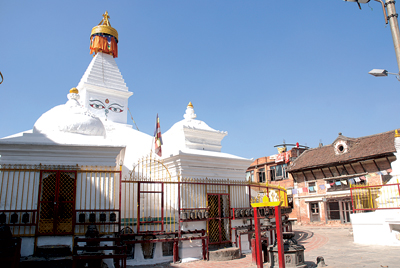 Gustatory delicacies
Gustatory delicacies
Lalitpur is a city dotted with temples, stupas, rich carvings and Viharas. There are also some excellent eateries in the city and it’s surrounding areas. Honacha (also mentioned as wohnacha) is a Lalitpur tradition and one of the most popular local delicacy-serving restaurant in the city. The place is popular for its woh (a pancake-like dish made of soaked and pounded lentils). Most other Newari specialties like chatamari and choyla are also available.
Another famous joint amongst locals for dal-bhat (rice and lentils) is Bijaya Bhojnalaya (meaning ‘eating house’ in Nepali) in Gwarko. The restaurant attracts patrons of all social classes. Their specialty is rich mutton curry lovingly prepared in the traditional way. The fried chicken is crisp and tasty. The varieties of achars (pickles), ghundruk (fermented preparation) and bhatmaas (soya beans) all add up to a tasty and filling meal.
There is also the Nagdaha lake and Bishram Batika, a restaurant on its shore. The restaurant is famous for their chhoyla (spicy, barbecued buff), bara, chatamari and alu taama (potatoes with young tender bamboo shoots). The wonderful location by the small lake adds to its charm. I have always had a weakness for Thakali food (from the arid Mustang region near Jomsom) and one of my missions on holidays is to search out good Thakali restaurants in Kathmandu. The Mustang Thakali Kitchen in Pulchowk on the way to Jhamsikhel is an excellent find. The mutton and the local chicken set are both good. The magic of Thakali (Thakalis are an ethnic group from the Thak Khola near Jomsom) food lies in the careful blending of spices. One of our recent discoveries has been the Samurai restaurant near Pulchowk on the way to the Patan Dhoka. Their Tibetan gyakok is excellent. Gyakok is a mildly spiced stew of cheese balls, vegetables and various types of meat gently stewing in a special vessel that keeps the food hot. The food can be had with rice or noodles.
Lalitpur has slowly eased its way into my heart. There are many problems with the city: dust, crowds, dirt, garbage, narrow roads and lack of space. However, its charm lies in its wonderful architecture, delightful public squares, lavishly carved temples and living wood, metal and stone working skills. This ancient, proud and beautiful city separated from Kathmandu by the holy Bagmati River is well worth a visit.








